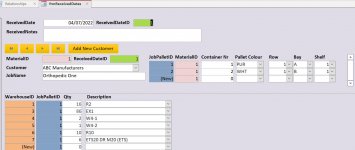I just want to brainstorm a bit before I begin full on developing something and see what others think. My thought process might end up a little disjointed so bear with me.
Background:
My work has a "bill and hold" area where the material is already invoiced and paid for, therefor it is customer property and is unable to be handled by our companies system any longer. To keep track of this material, we currently use a shared Excel file where all information is kept and updated by upwards of 5 people and lately they have had problems with several trying to access it at the same time and about a week ago became corrupted and was nearly lost.
Mission:
I would like to create an Access app that when material is received, all relevant information is entered, such as PO, catalog numbers, quantity, any damage, attach bill of lading and how many packages and/or pallets and other odds and ends. From there it would prompt them to enter/select bin locations based on number of pallets/boxes entered from a list of currently open locations (aisle, bay, row). With this, I do already see a slight problem as sometimes a single pallet could take up 2 spaces which would be the entire bay. Once all of this is entered and the locations are verified to be open, labels could be created to attach to the material (no barcodes, just visual labels).
Material would be kept under master project names, so when the first shipment arrives, the project would have to be created before the material could be entered. Once a job is complete and there are no more items stored under a project, it would ask if the project is complete and close the project if it is.
When material needs shipped, you will be able to open a project and see all the material that is under said project and select it and enter a quantity to ship that is up to the amount in that location, if you exceed the amount, you must choose another location to pull from. If the quantity in the location is not fully depleted, a new label would be created that would show the remaining quantity. If the entire amount is used, that bin location would become available for use yet again.
Based my thought process so far, how complicated would this be? Does anyone foresee hurdles to this?

